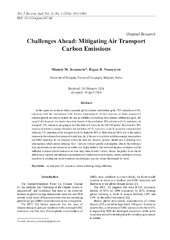Приказ основних података о документу
Challenges Ahead: Mitigating Air Transport Carbon Emissions
| dc.creator | Jovanović, Miomir | |
| dc.creator | Vračarević, Bojan | |
| dc.date.accessioned | 2021-09-24T15:36:17Z | |
| dc.date.available | 2021-09-24T15:36:17Z | |
| dc.date.issued | 2016 | |
| dc.identifier.issn | 1230-1485 | |
| dc.identifier.uri | https://gery.gef.bg.ac.rs/handle/123456789/798 | |
| dc.description.abstract | In this paper we confront widely accepted global climate stabilization goals (70% reduction of CO2 emissions) with the International Civil Aviation Organization's (ICAO) forecasts of future commercial aviation growth, in order to explore the real possibilities of realizing these climate stabilization goals. By using ICAO forecasts, we clearly show that, instead of the proclaimed 70% reduction of CO2 emissions, air transport's CO2 emissions are going to rise five-fold (4.9 times) in the 2005-40 period. But even if a 70% increase of aviation's energy efficiency and reduction of CO2 emissions could be somehow (miraculously) achieved, CO2 emissions of air transport would be higher by 50% in 2040 (than in 2005), due to the sudden increase in the volume of air-transport tourist trips. So, if the aim is to achieve ambitious energy consumption and GHG reduction for air transport within the next few decades, policies should aim at reducing total consumption, which means reducing VKT not just vehicle-specific consumption. Due to the extremely high growth rates in the volume of air traffic, it is highly unlikely that technical progress of engines will be sufficient to reduce overall emissions or even keep them at today's levels. Hence, the policy focus should shift to more rigorous and efficient implementation of market-driven instruments, which, apart from creating incentives to develop and use low-emission technologies, can also reduce the demand for travel. | en |
| dc.publisher | Olsztyn : HARD Publishing Company | |
| dc.relation | Ministry of Science and Technological Development of the Republic of Serbia | |
| dc.relation | info:eu-repo/grantAgreement/MESTD/Technological Development (TD or TR)/37010/RS// | |
| dc.rights | openAccess | |
| dc.source | Polish Journal of Environmental Studies | |
| dc.subject | air transport | en |
| dc.subject | CO2 emissions | en |
| dc.subject | radiative forcing | en |
| dc.subject | energy efficiency | en |
| dc.title | Challenges Ahead: Mitigating Air Transport Carbon Emissions | en |
| dc.type | article | |
| dc.rights.license | ARR | |
| dcterms.abstract | Јовановић, Миомир; Врачаревић, Бојан; | |
| dc.citation.volume | 25 | |
| dc.citation.issue | 5 | |
| dc.citation.spage | 1975 | |
| dc.citation.epage | 1984 | |
| dc.citation.other | 25(5): 1975-1984 | |
| dc.citation.rank | M23 | |
| dc.identifier.wos | 000385472400020 | |
| dc.identifier.doi | 10.15244/pjoes/62700 | |
| dc.identifier.scopus | 2-s2.0-84992702747 | |
| dc.identifier.fulltext | https://gery.gef.bg.ac.rs/bitstream/id/704/796.pdf | |
| dc.identifier.rcub | https://hdl.handle.net/21.15107/rcub_gery_798 | |
| dc.type.version | publishedVersion |


